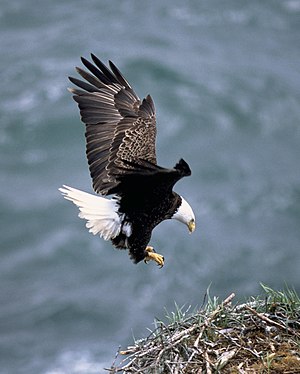Sea eagle
| Sea-eagles | |
|---|---|
 | |
| Bald Eagle (Haliaeetus leucocephalus) | |
| Scientific classification | |
| Kingdom: | Animalia |
| Phylum: | Chordata |
| Class: | Aves |
| Order: | Falconiformes (or Accipitriformes, q.v.) |
| Family: | Accipitridae |
| Genus: | Haliaeetus Savigny, 1809 |
| Species | |
Haliaeetus leucogaster
Haliaeetus sanfordi Haliaeetus vocifer Haliaeetus vociferoides Haliaeetus leucoryphus Haliaeetus albicilla Haliaeetus leucocephalus Haliaeetus pelagicus | |
A sea eagle (also called erne or ern, mostly in reference to the White-tailed Eagle) is any of the birds of prey in the genus Haliaeetus in the bird of prey familyAccipitridae.
Sea eagles vary in size, from the Sanford's Fish Eagle averaging 2–2.7 kg to the hugeSteller's Sea Eagle weighing up to 9 kg. At up to 6.9 kg, the White-tailed Eagle is the largest eagle in Europe. Bald Eagles can weigh up to 6.3 kg, making it the largest bird of prey (as the larger California Condor is now considered unrelated to the true raptors) native to North America. The White-bellied Sea Eagle can weigh up to 3.4 kg.Their diets consist mainly of fish and small mammals.
There are eight living species:
- White-bellied Sea Eagle (H. leucogaster)
- Sanford's Sea Eagle (H. sanfordi)
- African Fish Eagle (H. vocifer)
- Madagascar Fish Eagle (H. vociferoides)
- Pallas's Fish Eagle (H. leucoryphus)
- White-tailed Eagle (H. albicilla)
- Bald Eagle (H. leucocephalus)
- Steller's Sea Eagle (H. pelagicus)
Three obvious species pairs exist: White-tailed and Bald Eagles, Sanford's and White-bellied Sea Eagles, and the African and Madagascar Fish Eagles. Each of these consists of a white- and a tan-headed species, and the tails are entirely white in all adult Haliaeetus except Sanford's, White-bellied, and Pallas's.
Haliaeetus is possibly one of the oldest genera of living birds. A distal lefttarsometatarsus (DPC 1652) recovered from early Oligocene deposits of Fayyum,Egypt (Jebel Qatrani Formation, c.33 mya) is similar in general pattern and some details to that of a modern sea-eagle.The genus was present in the middleMiocene (12-16 mya) with certainty.
Their closest relatives are the fishing-eagles in the genus Ichthyophaga, very similar to the tropical Haliaeetus species. The relationships to other genera in the family are less clear; they have long been considered closer to the genus Milvus (kites) than to the true eagles in the genus Aquila on the basis of their morphology and display behaviour, more recent genetic evidence agrees with this, but points to them being related to the genus Buteo (buzzards) as well, a relationship not previously thought close.
The origin of the sea eagles and fishing-eagles is probably in the general area of theBay of Bengal. During the Eocene/Oligocene, as the Indian subcontinent slowly collided with Eurasia, this was a vast expanse of fairly shallow ocean; the initial sea eagle divergence seems to have resulted in the four tropical (and Southern Hemisphere subtropical) species found around the Indian Ocean today. The Central Asian Pallas's Sea-eagle's relationships to the other taxa is more obscure; it seems closer to the three Holarctic species which evolved later and may be an early offshoot of this northward expansion; it does not have the hefty yellow bill of the northern forms, retaining a smaller darker beak like the tropical species.
The rate of molecular evolution in Haliaeetus is fairly slow, as is to be expected in long-lived birds which take years to successfully reproduce. In the mtDNA cytochrome b gene, a mutation rate of 0.5–0.7% per million years (if assuming an Early Miocene divergence) or maybe as little as 0.25–0.3% per million years (for a Late Eocene divergence) has been shown.
A 2005 molecular study found that the genus is paraphyletic and subsumes Ichthyophaga, the species diverging into a temperate and tropical group.
Webcams
Nesting pairs of both the Bald Eagle and White-bellied Sea Eagle have been subject to live streaming web cam footage.
No comments:
Post a Comment